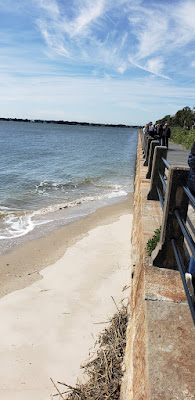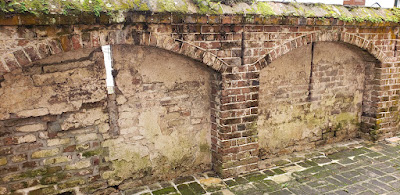Boy am I ready to be home! After 2 days of driving -- well Vernon driving mostly -- we are now at Anita and Karl's beach house in Lewes, DE. It's a beautiful sunny day, about 80 degrees and we mostly did laundry and clean up and a walk on Rehoboth boardwalk. Also Hopkin's Farm ice cream!
I'm going to post the rest of the pictures and stories about the history of Charleston before I forget them!
St Michael's Anglican Church with Vernon in the foreground walking toward it. It's the oldest surviving church in Charleston -- built in the 1750's "by order of the South Carolina Assembly". It stands at a crossroad in Charleston with a Federal building on one corner, a state government building on another, a local government building on another and St Michael's church on the 4th corner which has become known as the "Four corners of the Law": federal law, state laws, local laws, and God's law.Charleston was built "on the backs of slaves" and one of them planned the biggest revolt in American history which failed and he was executed. I wrote about him in yesterday's blog. But there is one story that Diana told that I loved because it was about a daring and successful escape from slavery. The "enslaved person's" name was Robert Smalls -- the slave that stole a ship! "He risked his life to liberate his family and became a legend in the process".
The first shots of the Civil War were in Charleston Bay. But a year later the many ships of the Union Army fleet were blockading all the major southern ports including the Charleston port. Even so, blockade runners regularly would sneak goods into and out of Charleston. Robert Smalls was a crew member of one of the Confederate ships, The Planter. He knew that he and his wife and 2 small children were due to be sold and separated. So he devised a daring plan which would have resulted in severe punishment or even death if they were caught. But he and his wife both felt it was worth the risk to be free.
He alerted the other slave crew members on the ship of his plan and when the three white officers left the ship to spend time with their families in Charleston, Smalls commandeered the ship by impersonating the captain and handed it over to the Union fleet out in Charleston Bay. A total of 17 black passengers (9 men, 5 women and 3 children) were freed from slavery that day. He became an officer in the Union Army and eventually a U.S. congressman!
This is not an alley -- it's a lane -- Longitude Lane with driveways and houses on both sides. It'ss just wide enough for a carriage to pass.
Ths is a house on Chalmers Street. The street is made of "ballast" which are the stones that were needed to weigh down the empty ships on the way over from England. They had to toss the stones out when they reached the port to make way for the goods they were picking up to bring back to England. So one use for these ballast stones was to make streets.
This has been fun keeping this record of our Florida and southeast coast travels this past month! Now we look forward to our biannual "Sibling weekend" with Vernon's siblings (Esther -- you are a sibling of course) and their spouses in Lewes. Then home!





























































